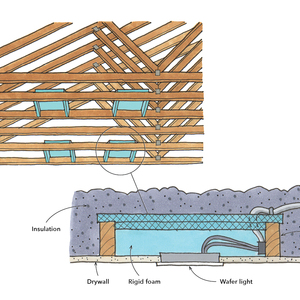Why Should I Use Mineral-Wool Exterior Insulation?
Learn how installing semi-rigid mineral wool outside of wall sheathing reduces thermal bridging and improves a home's energy efficiency.
In this short webinar from the Fine Homebuilding Summit, Rockwool Building Science Manager Antoine Habellion dives into the science and efficacy of using mineral wool for exterior insulation. Below is an overview of some of the concepts discussed, but check out the video to get the full details!
Heat Loss and Thermal Bridging
When we look at a typical house, we might have something around 30% of heat loss through the roof, 20% through the walls, and then a big loss through air-leakage and ventilation. Thermal bridging accounts for a big portion of this overall loss.
Thermal bridging is when you have a material with higher thermal conductivity transferring heat through an assembly with substantially lower thermal conductivity. Examples of this include steel studs in a wall filled with batt insulation or also a wood stud penetrating through batt insulation—these studs create a thermal bypass or bridge. The overall R-value of the wall (which explains how much the assembly resists heat flow) will go down because of thermal bridging. In the example I share here, we have 5% thermal bridging, so in order to get the best performance possible, you have to address thermal bridging.
Adding Exterior Insulation
Instead of increasing the size of the stud to create a deeper wall cavity and then adding more insulation in order to increase total R-value, a better solution would be to reduce the depth of our stud walls, which reduces the amount of batt insulation, but add exterior insulation. This is often done with rigid foam boards, but this is also possible with semi-rigid mineral-wool insulation. The only things penetrating our exterior insulation are fasteners, which makes for a more efficient insulation.
This mineral-wool solution is usually recommended for lightweight to medium-weight siding, but you can use this with almost any type of cladding. Adding the right amount of exterior insulation also ensures that you’re keeping your sheathing warm enough to stay above the dew point, which then keeps moisture from condensing on your sheathing.
In comparing this system with a similar system using foam, we found that for lightweight to medium-weight cladding, the performance was very similar to what you would experience with XPS.
RELATED LINKS:
- Installing Rockwool for Continuous Exterior Insulation
- Crash Course in Control Layers
- Thermally Broken Studs

























